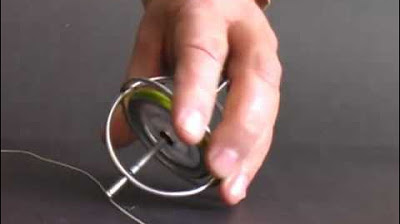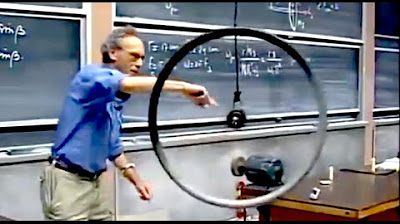Gyroscopic Precession is Easier Than You Think!
TLDRThe video script explains the phenomenon of gyroscopic precession, a concept where a spinning object like a wheel behaves in unexpected ways due to its angular momentum and rigidity in space. It demonstrates how gyroscopes, found in everyday technology, maintain their axis due to gyroscopic inertia and how applying torque causes them to precess or tilt rather than rotate directly. The right-hand rule is used to determine the direction of angular momentum and torque, allowing the prediction of a gyroscope's behavior. The video also shows how gyroscopic precession can seemingly defy gravity, as seen in spinning wheels balancing on a string.
Takeaways
- 🎥 Gyroscopes and precession are common in technology, medicine, and even Earth's rotation.
- 🔄 A gyroscope is a spinning object, like a wheel, with properties of rigidity in space and precession.
- 💫 Rigidity in space is the tendency of a spinning object to maintain its axis of rotation, also known as gyroscopic inertia.
- 🔄 Precession is the change in direction of a gyroscope's axis due to an applied torque.
- 📈 Angular momentum (ℏ) and torque (τ) are key concepts in understanding gyroscopic precession.
- 👆 The right-hand rule helps determine the direction of angular momentum and torque.
- 🌀 When a spinning wheel is torqued, it doesn't rotate in the direction of the torque but precesses to follow it.
- 🎢 Gyroscopes can seemingly defy gravity, as seen in demonstrations where a wheel balances on a string.
- 🤹♂️ Gyroscopes' ability to maintain their axis of rotation is utilized in various applications like robotics, aviation, and smartphones.
- 🚀 Gyro technology must account for gyroscopic precession to function correctly in devices and machinery.
Q & A
What is the phenomenon being discussed in the video?
-The phenomenon being discussed is gyroscopic precession.
What are the two special properties of gyroscopes?
-The two special properties of gyroscopes are rigidity in space and precession.
What does rigidity in space refer to?
-Rigidity in space refers to a spinning object's tendency to maintain the axis on which it's spinning, also known as gyroscopic inertia.
How is angular momentum denoted in the context of the video?
-Angular momentum is denoted with a capital L in the context of the video.
What is the right-hand rule and how is it used in the video?
-The right-hand rule is used to determine the direction of angular momentum and torque. By curling the four fingers of the right hand along the arc of the spin, the thumb points in the direction of the angular momentum.
What happens when a torque is applied to a spinning wheel?
-When a torque is applied to a spinning wheel, the angular momentum changes to follow the torque, resulting in the wheel tilting or precessing to follow the torque vector. This is known as gyroscopic precession.
How does the wheel appear to defy gravity in the video demonstration?
-The wheel appears to defy gravity because the continuous torque due to gravity causes the angular momentum to change direction, making the wheel rotate around in circles while spinning on its axis.
What are some applications of gyroscopic technology?
-Gyro technology has applications in robotics, medicine, aviation, space exploration, and smartphones.
Why is gyroscopic precession important in gyrotechnology?
-Gyroscopic precession must always be accounted for in gyrotechnology because it can affect the performance and accuracy of devices and systems that rely on gyroscopic principles.
How does the spinning wheel in the video maintain its balance on a string?
-The spinning wheel maintains its balance on a string due to gyroscopic precession. The wheel's angular momentum follows the torque applied by its weight, causing it to rotate around its axis and appear to defy gravity.
What happens to the wheel's balancing act when it slows down?
-When the spinning wheel slows down, the balancing act will eventually stop as the angular momentum can no longer chase the torque, causing the wheel to lose its defied gravity appearance and come to a rest.
Outlines
🎥 Introduction to Gyroscopes and Precession
This paragraph introduces the concept of gyroscopic precession, explaining how spinning objects like wheels exhibit unexpected behaviors due to their rigidity in space and pre-session. It mentions the ubiquity of gyroscopes in technology and everyday life, from devices and medicine to the Earth's rotation. The paragraph also explains the basic properties of gyroscopes, such as their tendency to maintain their axis of spin (rigidity or gyroscopic inertia) and the phenomenon of pre-session, which will be further elaborated by the end of the video.
🚀 Understanding Angular Momentum and Gyroscopes
This section delves into the principles of angular momentum and torque, using the right-hand rule to determine the direction of these forces. It explains how a spinning wheel's angular momentum follows the applied torque, leading to gyroscopic precession, where the wheel tilts or precesses in a direction that seems unnatural. The paragraph provides examples of how to predict the wheel's behavior by identifying the direction of angular momentum and torque, and how they interact to cause precession.
🌐 Applying Gyroscope Principles to Real-World Phenomena
The final paragraph applies the concepts learned to real-world examples, such as a spinning wheel balancing on a string and defying gravity. It guides the viewer through the steps of identifying angular momentum and torque using the right-hand rule and predicting the wheel's precession. The paragraph emphasizes the importance of accounting for gyroscopic precession in gyrotechnology and highlights the wide range of applications for gyroscopes in various fields.
Mindmap
Keywords
💡Gyroscopic Precession
💡Rigidity in Space
💡Angular Momentum
💡Torque
💡Right-Hand Rule
💡Hockey Puck Example
💡Gyroscope
💡Vector
💡Balancing Act
💡Gyro Technology
Highlights
Gyroscopic precession is the phenomenon that allows spinning objects to behave in seemingly unnatural ways, such as spinning in unexpected directions or balancing on a string.
Gyroscopes are common in everyday technology, medicine, and even influence the rotation of the Earth.
A gyroscope is a spinning object like a wheel or propeller and has two special properties: rigidity and precession.
Rigidity in space, also known as gyroscopic inertia, is the tendency of a spinning object to maintain its axis of rotation.
The faster a gyroscope spins, the higher its rigidity in space.
Precession is the change in the direction of angular momentum of a spinning object when a torque is applied.
The right-hand rule is used to determine the direction of angular momentum and torque in a gyroscope.
Angular momentum always points along the axis of rotation in a gyroscope.
Gyroscopic precession occurs when a spinning wheel tilts or precesses to follow the applied torque rather than simply rotating in the direction of the torque.
Gyro technology has a wide range of applications in robotics, medicine, aviation, space exploration, and smartphones.
Gyroscopic precession must be accounted for in the design and use of gyroscopic devices.
The video demonstrates how to predict the behavior of a spinning wheel under gyroscopic conditions by finding the angular momentum, torque, and new angular momentum.
The wheel balancing act on a string defies gravity through continuous rotation and precession driven by the torque from the wheel's weight and the angular momentum.
The video provides practical examples and exercises for viewers to understand and apply the concept of gyroscopic precession.
Gyroscopic precession is a fundamental concept that explains the behavior of spinning objects under various forces and torques.
The video concludes by emphasizing the importance of understanding gyroscopic precession in the field of gyrotechnology.
Transcripts
5.0 / 5 (0 votes)
Thanks for rating:





